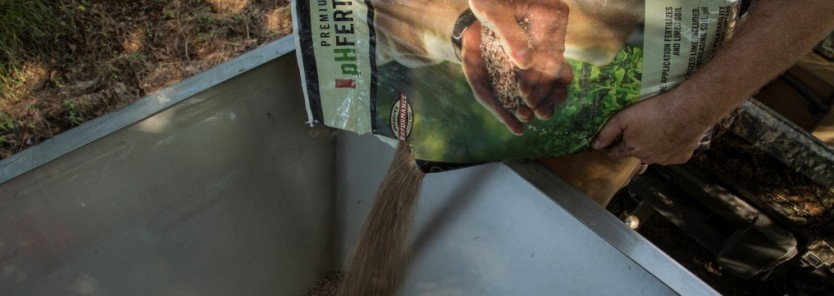The fall food plot season is in full swing and the questions have been pouring in on what type of fertilizer to use and what your soil sample means. Here are some quick tips to help you understand what you need for your plot.
Fertilizer and lime recommendations can be confusing. All the different numbers and suggestions can really make it difficult to understand what your soil and crop needs to perform its best.
Soil pH
Soil pH is the first thing you need to get right. Although some crops are more tolerant of acidic soils than others, your plot will perform best with a pH of 6.5-7.0. Lime is relatively inexpensive and is really important for successful plots. For perspective, a plot with a pH of 5.5 is 10 times more acidic than one at 6.5. Over 50% of fertilizer added to a plot with a 5.5 pH is wasted because it is not able to be used by the plants. 1-2 tons per acre of ag lime is very common to get your plots where they need to be.
Understanding N-P-K
Remember that the 3 numbers on bagged fertilizer (N-P-K) are based off of 100lbs, not 50. In a 50lb bag of 13-13-13, there are 6.5 lbs or units each of actual nitrogen, phosphorous, and potassium. If your sample says you need 40lbs each of N-P-K, you would need 350lbs per acre of 13-13-13. This would give you 45.5 lbs of N-P-K.
Advanced Soil Test
An advanced soil test is needed to get current levels of micro nutrients like copper, iron, zinc, boron, etc. These micros are usually not present in bagged fertilizer. Although they are needed in very small amounts in comparison to the macro’s (N-P-K), it can be worthwhile to do an advanced sample every 3-4 years and keep the micro’s up to date.
As a general rule of thumb, cereal grains like wheat, oats, rye, and triticale as well as all brassica family plants are nitrogen lovers. Legumes such as clovers, peas, beans, or alfalfa fix their own nitrogen from the atmosphere and need very little at planting time. For example, once established, clover can be fertilized with a common 0-20-20. At planting time, a low nitrogen blend like 5-20-20 can be used to give the young clover a small dose of nitrogen while it develops a root system and begins to affix its own from the air. Before planting, look at the varieties of seed in the blends you are planting and make a decision on what fertilizer blend is going to be needed. For help understanding your soil samples, email adelano@mossyoak.com.








